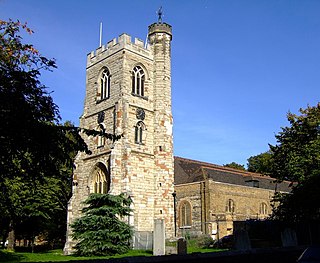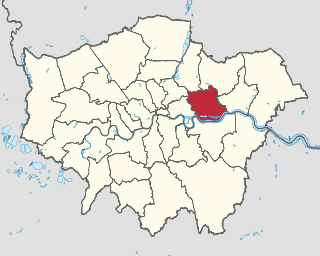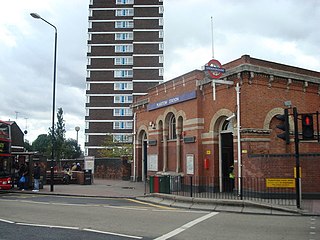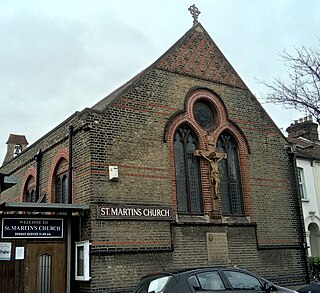
West Ham is an area in East London, located 6.1 mi (9.8 km) east of Charing Cross in the west of the modern London Borough of Newham.

The London Borough of Newham is a London borough created in 1965 by the London Government Act 1963. It covers an area previously administered by the Essex county boroughs of West Ham and East Ham, authorities that were both abolished by the same act. The name Newham reflects its creation and combines the compass points of the old borough names. Situated in the Inner London part of East London, Newham has a population of 387,576, which is the third highest of the London boroughs and also makes it the 16th most populous district in England. The local authority is Newham London Borough Council.

Plaistow is a suburban area of East London, England, within the London Borough of Newham. It adjoins Upton Park to the north, East Ham to the east, Beckton to the south, Canning Town to the south-west and West Ham to the west.

Essex is a county in the East of England which originated as the ancient Kingdom of Essex and one of the seven kingdoms, or heptarchy, that went on to form the Kingdom of England.

West Ham was a local government district in the extreme south west of Essex from 1886 to 1965, forming part of the built-up area of London, although outside the County of London. It was immediately north of the River Thames and east of the River Lea.

Stratford Langthorne Abbey, or the Abbey of St Mary's, Stratford Langthorne was a Cistercian monastery founded in 1135 at Stratford Langthorne — then Essex but now Stratford in the London Borough of Newham. The Abbey, also known as West Ham Abbey as it lay in that parish, was one of the largest Cistercian abbeys in England, possessing 1,500 acres (6.07 km2) of local land, controlling over 20 manors throughout Essex. The Abbey was self-sufficient for its needs and wealthy besides; some of this wealth came from the ecclesiastic mills grinding wheat for local bakers to supply bread to the City of London. This later led to competition with the Guild of Bakers, who sought powers to levy a toll on loaves entering the City at Whitechapel.

St Mary's Church is a Church of England church in Plaistow, east London. With the three churches of St Matthias’, St Martin's, and St Philip and St James’, it now forms part of the Parish of the Divine Compassion. Its Victorian building, designed by Sir Arthur William Blomfield in 1890-1894, was demolished in 1976. They now worship in a smaller church built in 1981.

St Matthias' Church is a Church of England parish church in Canning Town, east London. The modern building comprises a chapel, community rooms and a home for residents with disabilities.

St Martin's Church is a part of the Church of England on Boundary Road in Plaistow, Newham, East London. It was built in 1894 as a mission church, with the foundation stone laid on 28 June that year by Henrietta Pelham-Clinton, Dowager Duchess of Newcastle and widow of the 6th Duke of Newcastle - she was a major benefactress in the area and also funded the opening of St Thomas' Roman Catholic Church in Woodford the following year.

St Erkenwald's Church is a Church of England parish church on Levett Road, Barking in Greater London. It was established as a temporary church in 1934, which was only replaced by a permanent red-brick church twenty years later – the latter was part-funded by money from a War Damage payment for Holy Trinity Church, Canning Town, destroyed in the London Blitz. It is dedicated to Earconwald, one of the founders of Barking Abbey and brother to its first abbess Ethelburga.

St Luke's Church, Canning Town or St Luke's Church, Victoria Docks is a Church of England church, originally housed in a building on Boyd Road in the Royal Docks area of West Ham in east London.

St Paul's Church, Stratford is a Church of England church in Stratford, London. It had its origins in a Sunday School opened in Stratford New Town by a City Missionary around 1850, for which a building was constructed on Queen Street by Samuel Gurney in 1853, within the parish of St John's Church, Stratford. St John's vicar William Holloway was ambivalent about the mission and so friction arose when the vicar of All Saints, A J Ram, bought a site for the mission to build a church, initially an iron hall in 1859 and a permanent church in 1864, both dedicated to St Paul. The latter was built with assistance from Thomas Fowell Buxton and Raymond Pelly. The permanent church was then assigned a separate parish in 1865, split from that of St John's. The church was destroyed by a V-weapon in 1945, but was replaced by a new building, consecrated in 1953.

St Andrew's Church was a Church of England church on Barking Road in Plaistow, east London. It began as a small mission built in 1860 on Whitwell Road by St Mary's Church, Plaistow. A permanent church designed by James Brooks opened in 1870 on a site just south of the northern outfall sewer embankment and a separate parish assigned to it the following year. A large central crossing tower with a pyramidal spire was planned but only completed as far as the ridge of the nave roof.
St Gabriel's Church, Canning Town was a Church of England church in Canning Town, east London. It originated as an undedicated iron church between the River Lea and the railway to the north of the Barking Road, on the site later used for the brick-built permanent church of St Gabriel's, consecrated in 1876. Initially a mission of All Saints Church, West Ham, it was given a parish of its own three years after the consecration, using parts of those of All Saints, St Mary's and St Andrew's. It was damaged in the London Blitz and demolished around 1955, with its parish split between St Matthias and St Luke's in 1961.
St Peter's Church was a Church of England church on Upton Lane in the Upton Cross area of Newham, East London. Its origins were in a mission of St Mary's Church, Plaistow on Pelly Road, holding services in a barn then in an iron church. Joseph Lister's former home Upton House was bought by the bishop of St Albans in 1885, becoming the vicarage, whilst its garden provided the site for a permanent church, built in 1893 and given a separate parish the following year using parts of those of All Saints, St Mary's, Emmanuel and St Stephen's. The parish was merged into that of Emmanuel in 1962 - the church was left standing as a chapel of ease to Emmanuel, but its vicarage was demolished, the site being sold in 1968. Funds from that sale and the sale of the parish hall were intended for a new church, church hall and clergy house, but in 1972 St Peter's Church was declared redundant, demolished and its site sold off, leading to the scheme's abandonment three years later.
St Barnabas' Church, West Silvertown was a Church of England church in Silvertown, east London. It was opened in 1882 on Eastwood Road as a mission church of St Mark's Church, Silvertown. In the 1917 Silvertown explosion its chancel and iron hall were destroyed, leaving the church to use temporary buildings until the completion of a new church and the formation of a separate parish for it, both in 1926. The new parish was mainly drawn from St Mark's, though it also took a small part of the parish of St Luke's Church, Canning Town. The vicar of St John's Church, North Woolwich administered it after 1945. The parishes of St John, St Mark and St Barnabas were merged in 1974 to form the parish of North Woolwich with Silvertown.
St Cedd's Church was a Church of England church between Newham Way, and Chadwin Road, in Canning Town, east London, dedicated to Cedd, evangelist to Essex, in whose ceremonial county the church falls. Opened as a brick hall in 1903-1904 as a mission of St Andrew's Church, Plaistow, it had a mission district assigned using parts of the parishes of St Andrew's and St Luke's in 1905. That mission district was turned into a separate parish in 1936, for which a new redbrick church was completed in 1939. Part of the former parish of Holy Trinity Church was assigned to St Cedd's in 1961, though the latter is no longer an Anglican church. Fire damaged in 1995, it was restored and re-opened in 2007 to house the London Ghana Seventh-day Adventist congregation

St Mary's Church, Ilford or St Mary's Church, Great Ilford is a Church of England parish church in Ilford in the London Borough of Redbridge. A new ecclesiastical parish for Great Ilford was split off from that of Barking in 1830 and its church building completed the following year. The church's principal benefactor was Robert Westley Hall-Dare, M.P. His daughter, Mary Hall-Dare, laid the foundation stone and the church was opened on June 9th, 1831 by Charles James Blomfield, Bishop of London, “and the day was spent in general festivity from the highest to the lowest classes”. Its first vicar was appointed in 1837 - its advowson was initially vested in All Souls College, Oxford. A tower was added in 1866 and a chancel, lady chapel and vestries in 1920. St Clement's Church was completed as a chapel of ease for it in 1896, before becoming the parish's main church in 1902.

St Cedd's Church, Barkingside is a Church of England parish church in the Barkingside district of Ilford in the London Borough of Redbridge, dedicated to Cedd, bishop of Essex, in which Ilford historically fell. In 1938 a temporary church was built and a conventional district set up using parts of the parishes of Holy Trinity, Barkingside and Holy Trinity, South Woodford.

The Memorial Community Church is a Baptist church in Plaistow, Newham, east London. Neo-Byzantine in style, it is grade II listed.
















